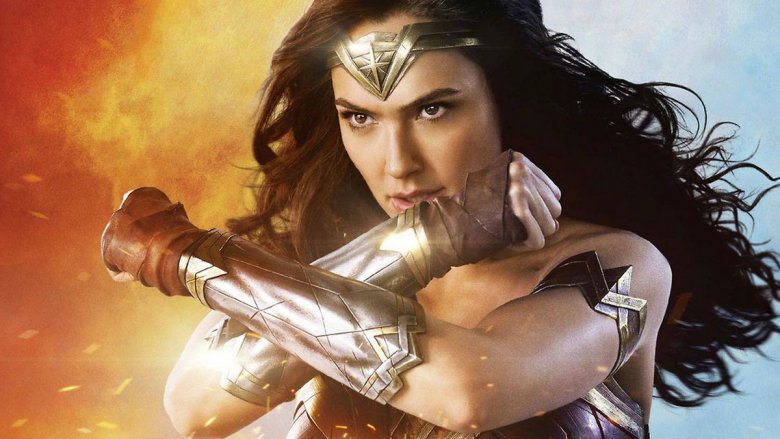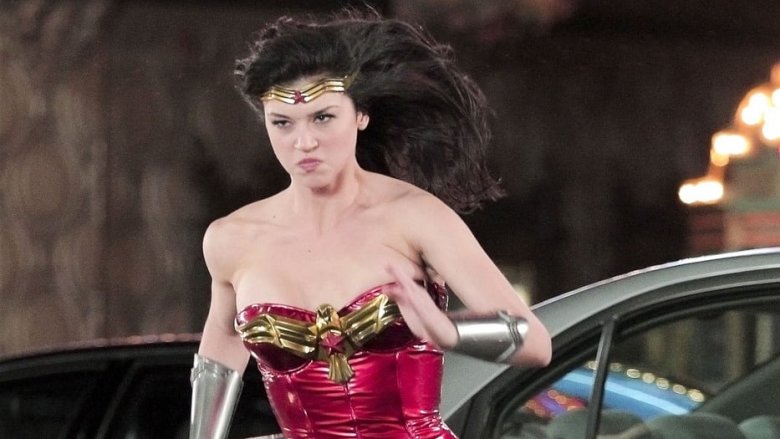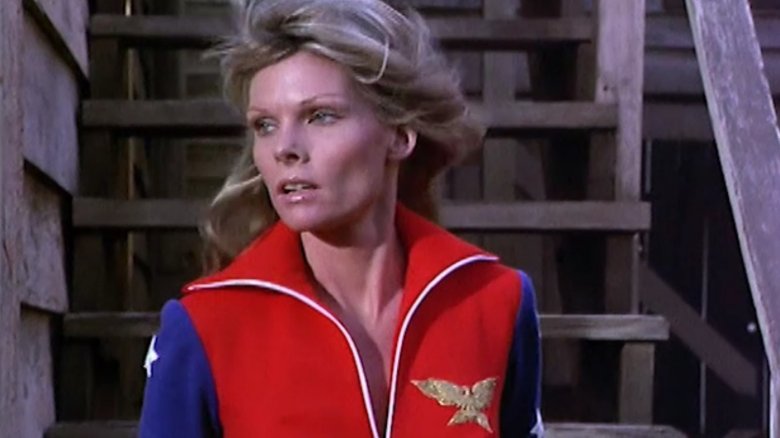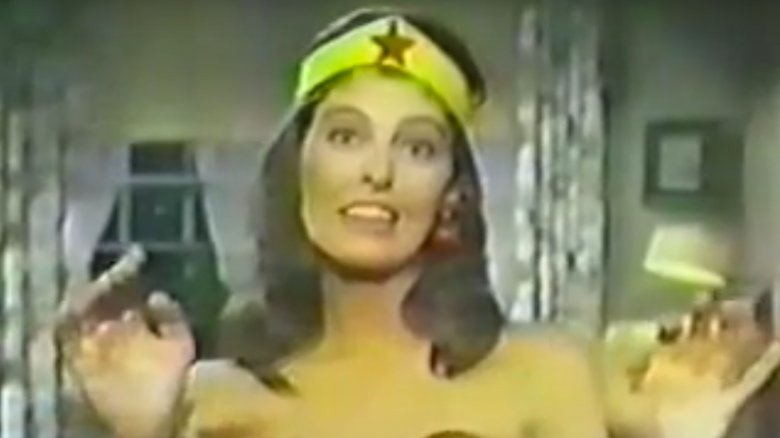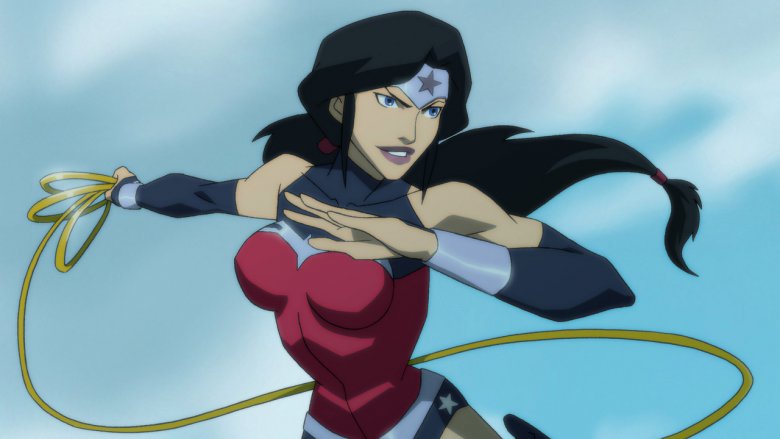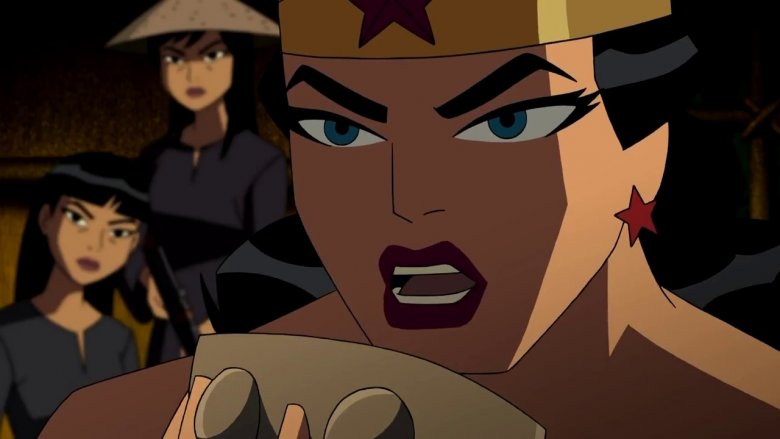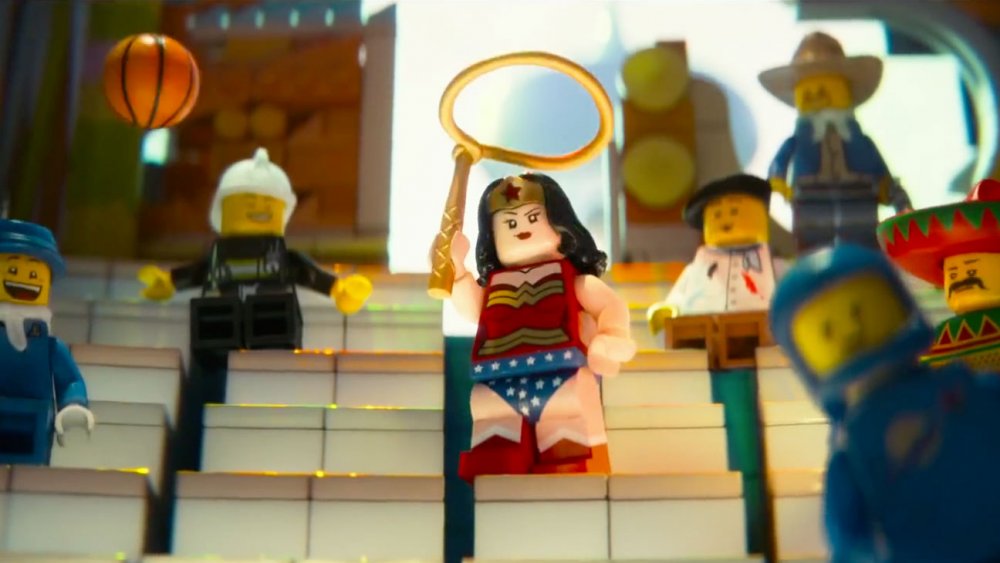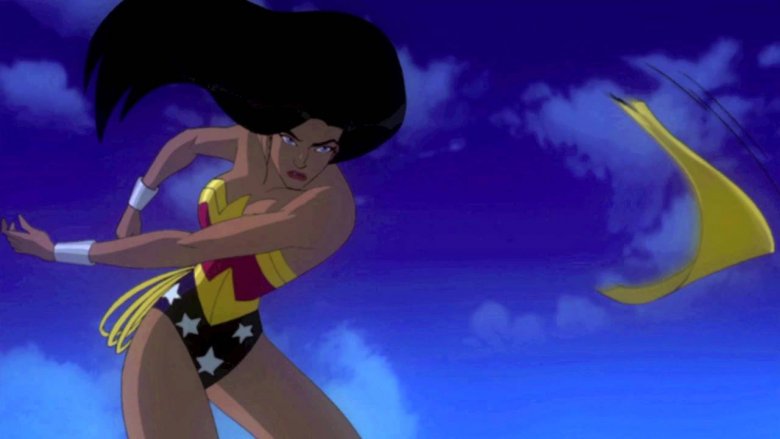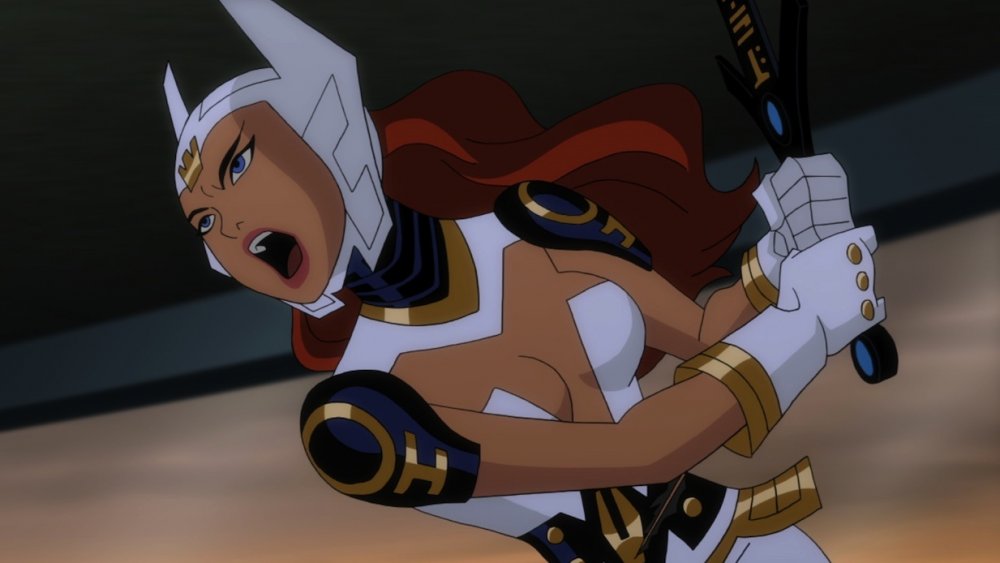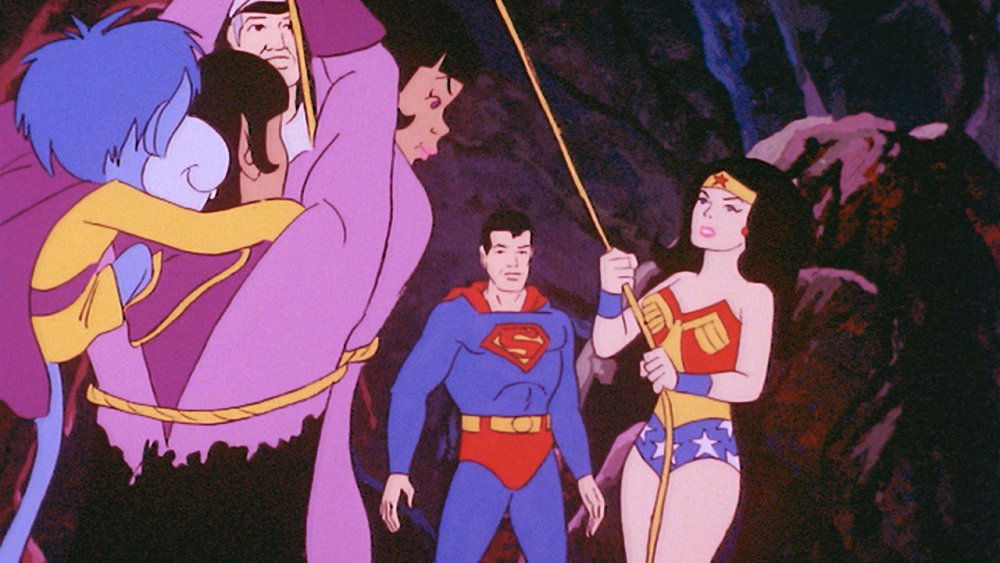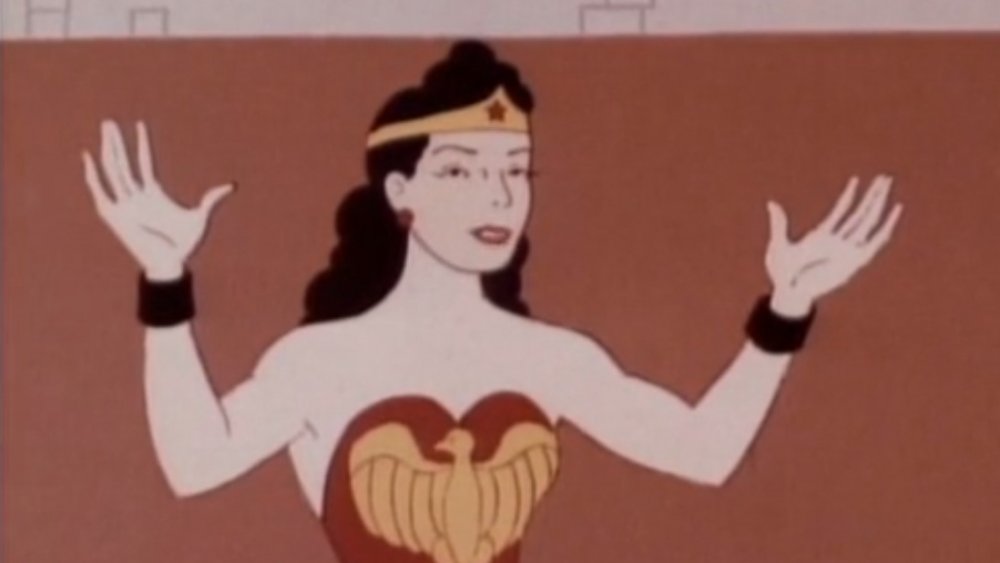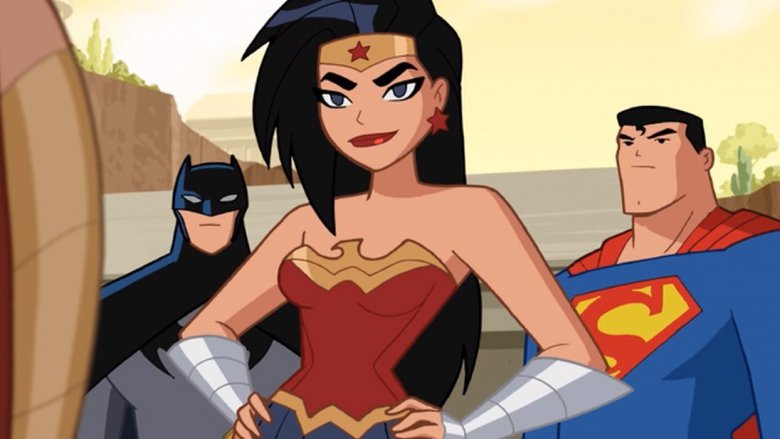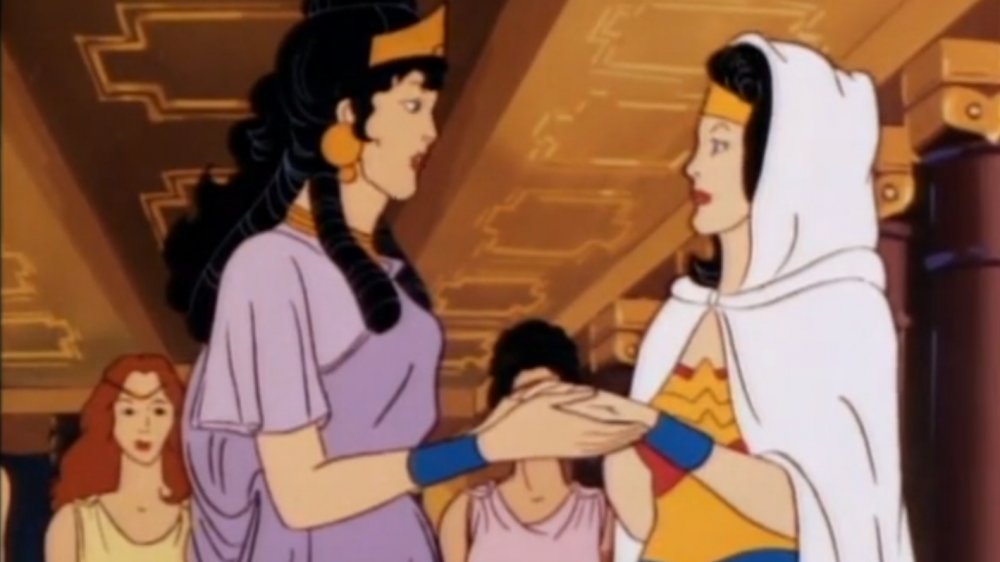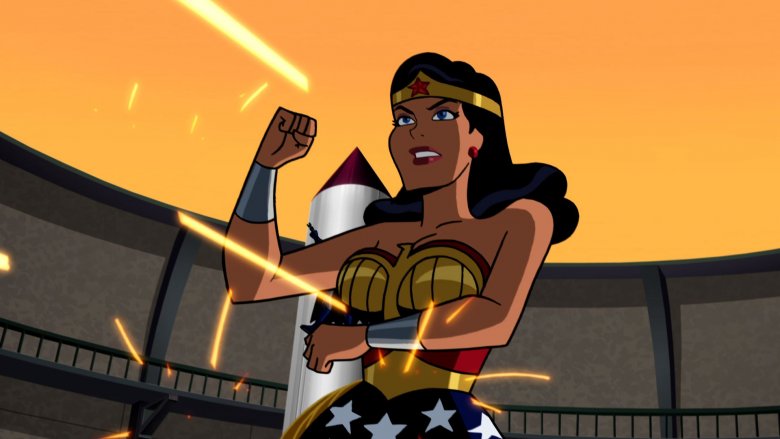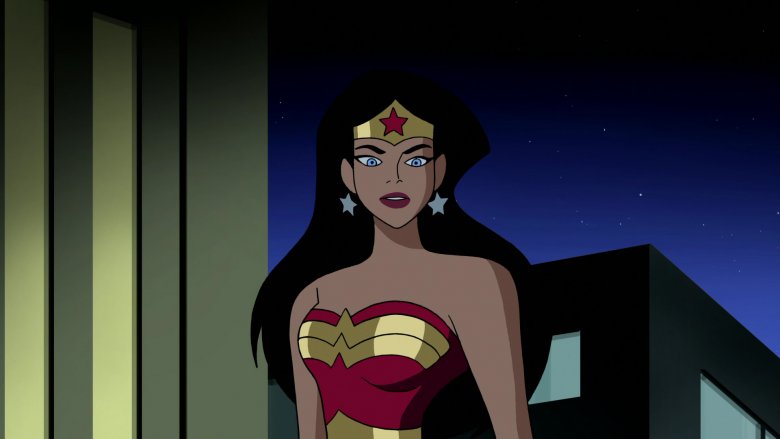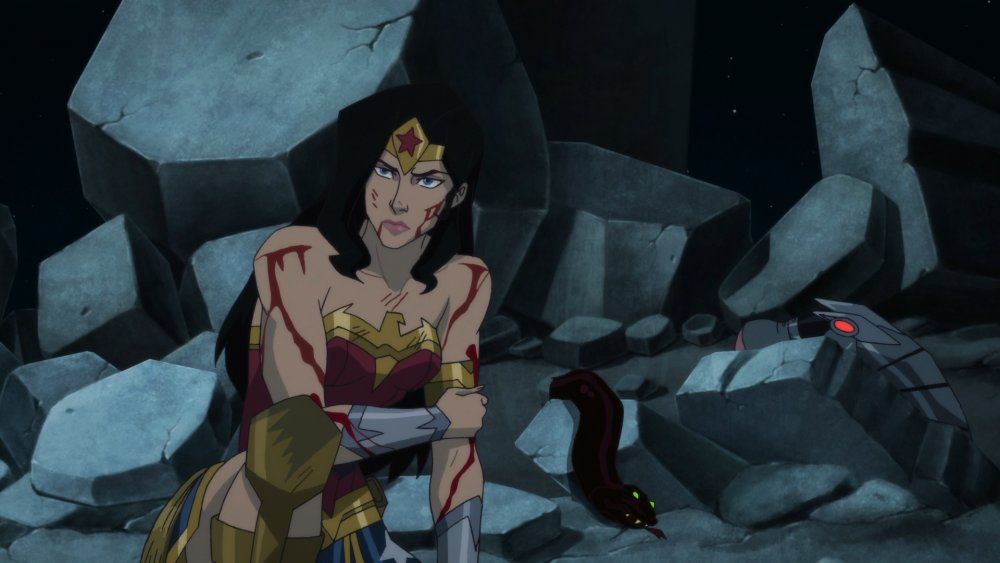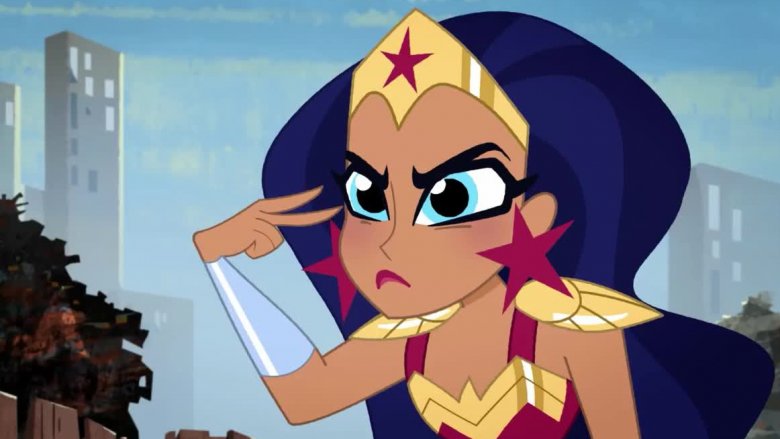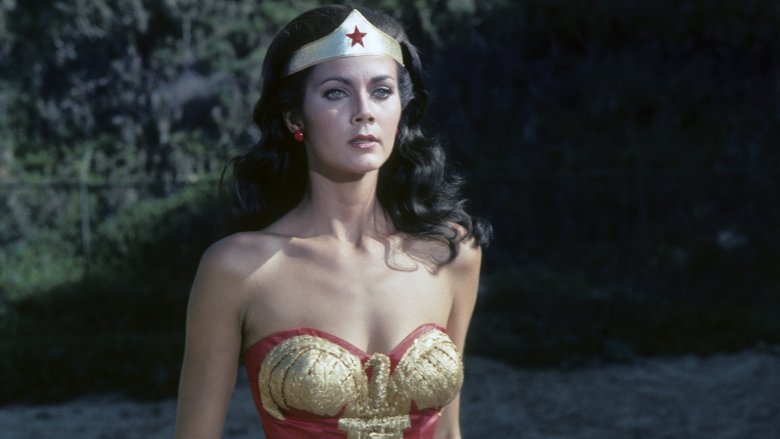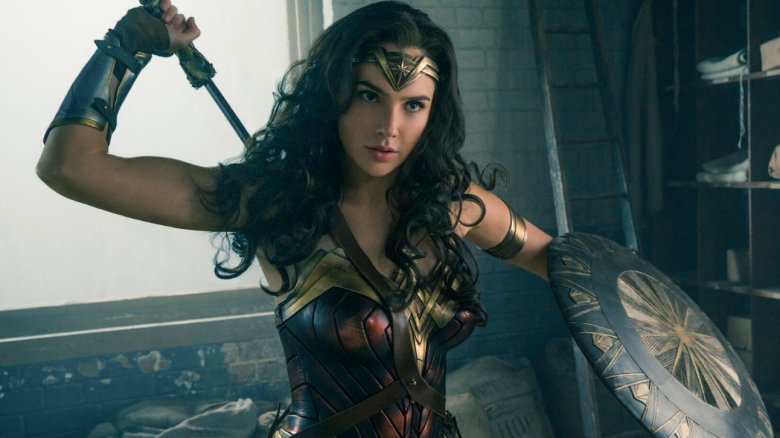Every Screen Adaptation Of Wonder Woman Ranked Worst To Best
Beautiful as Aphrodite, wise as Athena, strong as Hercules, and swifter than Hermes, she is the one and only Wonder Woman. Sent to save Man's World from itself with the power of truth, justice, and mercy, Wonder Woman searches high and low for wrongs to right, oppressors to uproot, and general mayhem to quell. She is an icon of 20th century feminism, an emblem for emancipation in the modern world.
Like any long-running superhero, Wonder Woman has seen her share of adaptations — and as is always the case, they range in quality. Some are intriguing artifacts of bygone ages, in which her costume was more reminiscent of regulation gym shorts than the armored gladiator gear we see in today's multiplex. Some are misguided examples of ill intent, odd aesthetic choices, and outright stupidity. None are worth ignoring, even the worst, as each and every Wonder Woman screen adaptation reveals something about what Wonder Woman means to the world — and just how messy that meaning can be. Join us as we explore the highs and lows of the Amazon princess, from 1960s homebody to 2000s career girl.
NBC's canceled Wonder Woman pilot
What do people love about Wonder Woman? Is it her bravery, her ceaseless commitment to good, her fighting prowess? Perhaps her stranger-in-a-strange-land nature and all the interesting commentary on our world it enables? Maybe her earnest belief that no one is beyond redemption? Fans might not agree on every single one of those attributes, but few would call them entirely off the mark.
The minds behind the canceled 2011 Wonder Woman TV series starring Adrienne Palicki disagreed. Rather, as the unaired pilot argues, people like Wonder Woman because beneath the lasso and bracelets, she's just a silly bachelorette who wants to flop onto her couch with her cat and a glass of wine to catch a screening of The Notebook. It's not all bad, exactly — though the series takes some serious left turns in imagining Diana as the CEO of "Themyscira Industries," a company we see as chiefly concerned with selling buxom dolls of their vigilante boss, it's also not afraid to show her eager to do what's right and stand up against her own objectification. But the overwhelming impression is that of a series embarrassed by its own source material. Add in a limp lead performance and some truly clumsy camera work, and you get one of the most disappointing Wonder Woman adaptations of all time.
1974's Wonder Woman TV movie
Audiences worldwide might remember Lynda Carter's twirling, tiara-sporting Wonder Woman as an emblem of 1970s entertainment, but they're significantly less likely to recall her 1974 predecessor. That Wonder Woman was played by tennis pro Cathy Lee Crosby, only one year before Carter's Amazon princess would take the small screen by storm.
Why did one iteration so eclipse the other? Well, right off the bat there's Crosby herself. Clad in a reinterpretation of Wonder Woman's classic costume that looked more like a fleece ski vest than anything else, this Diana wasn't much more than a generically judo-flipping warrior, pitted against villains no one was likely to remember the next day. Of the many liberties taken, from Diana's blonde hair to the rogue Amazon Ahnjayla who promises bloody revenge, not one of them improved upon the classic canon. Years later, Crosby's Wonder Woman is mostly a footnote in the character's history — a justified fate for an enterprise so alienated from its origins.
1967's Who's Afraid of Diana Prince? pilot
Before Lynda Carter or Cathy Lee Crosby, there was another Diana Prince. She was played by Ellie Wood Walker, and boy, was she in dire straits.
Little is known about this failed Wonder Woman adaptation: all that's been left behind is five minutes of footage. And really, Walker does an admirable job with the material she's given. A 27-year-old still living with her mother, she's bullied for being unmarried until she realizes the thunderstorm raging outside will prevent Steve Trevor — still a pilot in this incarnation, apparently — from taking off. She heads behind a revolving door, only to emerge played by Linda Harrison in a Wonder Woman costume.
Peculiarly, the show's voice-over mocks her for merely "thinking" she's beautiful, despite the fact that Harrison is clearly stunning. She then takes off into the stormy skies with a comic click of her heels, leaving behind a truly bizarre work of entertainment. As a 1966 Batman-style take on Wonder Woman, it sort of works, and Walker manages to bury the seeds of what could have been a genuinely funny performance in those scant five minutes. But the angle makes no sense. What does making Wonder Woman so silly accomplish? Why not play her absurdities straight, as Batman did to campy greatness? We'll never know what might have been, and perhaps that's for the best.
Justice League: War
Amazons are warriors. This has been part of their history since the Greek mythology that helped inspire Wonder Woman's creation, and has always been one of the character's essential attributes. But before she is a wager of war, she is a scholar, a dreamer, and a seeker of truth. As she once noted in the pages of her comics, Amazons "don't raise [their] hand at all until [they've] first extended it."
The Wonder Woman of Justice League: War and the other direct-to-DVD DC animated movies that share its continuity might beg to differ. She is absolutely fearsome with her fists, the kind of hero who stands before any angry crowd and asks for the man responsible for their anger so she might make him "taste steel." It can be thrilling to watch such an action-minded Wonder Woman, and many of her fight scenes are impeccably choreographed and animated. But it's tiring, after a while, to see her constantly with sword in hand. Add in a weak romance with Superman, and this Wonder Woman feels more like a petulant adolescent's idea of "cool" than a hero with history and a mission.
The New Frontier
Based on Darwyn Cooke's classic limited comics series, The New Frontier blends the militaristic machinations of Cold War policy with the bright-eyed idealism of World War II-era superheroism. It's a trenchant commentary on the limits of power, governmental overreach, and international idealism, and the animated adaptation largely lives up to its source material. But when it comes to Wonder Woman, those successes are a bit more muddied.
This Wonder Woman has been beaten down by postwar disillusionment. Once, perhaps, she was a hopeful dreamer full of can-do spirit and Themysciran wisdom. Now she allows women caught in the midst of the Vietnam War to murder their abusers. This isn't a completely wrong-headed adaptational choice, and Lucy Lawless' steely performance is superb. But with scenes like the one that concludes with her directing a judgmental Superman to the door, one in which her fellow Amazons deride her leadership, and one when she crash-lands her blood-splattered jet into a military base, it's all a little dire for a character so closely aligned with optimism. All in all, it's an interesting departure from the character's history, but not one to be indulged for very long.
The Lego Movie
As far as superheroes go, Batman has the biggest part to play in The Lego Movie. So much so, in fact, that he's the hero's romantic rival, gets his own theme song, and was, ultimately, given a movie all to himself. But he's not the only DC hero pounding Bricksburg's pavement — Wonder Woman is there too, lasso in hand, as capable in plastic as she is in the flesh.
For, well, all of 30 seconds. True, she's not a major part of The Lego Movie, with all of two lines that add up to a combined eight words. But the sheer fact of her existence within the candy-colored confines of The Lego Movie's world is enough to merit her a place on this list. Here, Wonder Woman is a Master Builder, a being of unparalleled creativity and vision. Though these movie's moral is, ultimately, that anyone can be a Master Builder, audiences are informed that the ones who earned the title pre-movie worked for years "to clear their minds enough to have even a fleeting glimpse of the Man Upstairs." The Man, a father from our world to whom all the movie's characters are simply Lego figurines, is the god who grants them life, and, simultaneously, the devil who threatens their free-wheeling existence. Now ask yourself: who can't be charmed by the idea of a Wonder Woman who guards creativity itself from a literal patriarch, bent on keeping his toys from being played with?
2009's animated movie
Wonder Woman is easily the best part of her 2009 animated movie. She maintains a tireless faith in the world, her ideals, and her abilities. Watching her throw down with Ares is thrilling. The sequence in which she steps into her costume for the first time is stirring. She's everything you want her to be, really. The reason this version isn't higher on the list has everything to do with the movie around her.
Wonder Woman seems to believe it needs to apologize for its stalwart heroine by constantly sexualizing her and the culture she comes from. This iteration of Steve Trevor is an absolute sleazeball who can barely go five minutes without making it clear that Diana and her sisters matter most to him as babes. Yes, he comes to respect Diana as a warrior in her own right by the end of the movie, but the fact that their romance succeeds at all when so much of their interaction consists of Steve making her uncomfortable lessens her character. Would Wonder Woman fall for a man who sneers at her mother's long-since-past liaison with Ares as a stupid woman falling for a "bad boy," let alone one who refers to her as "the hot chick" to her Amazon sisters? This movie argues she would, and that's why this iteration misses the mark.
Justice League: Gods and Monsters
Superheroes thrive in alternate universes. What if the Justice League were an invention of feudal Japan? What if Wonder Woman had faced Jack the Ripper? What if the Kents had gotten a flat tire on their way to discovering baby Kal-El? All these concepts and more have been explored within the pages of DC Comics — and the tradition continues to flourish today, in stories like Justice League: Gods and Monsters. Within the cynical confines of its DC universe, Superman is the son of General Zod, Batman is a literal vampire, and Wonder Woman is Bekka, a New God from DC's Fourth World comics. Their approach to enforcing global order is considerably more brutal than their mainstream counterparts — consider its Wonder Woman. She might believe in justice, but she's a lot less into lassos and a lot more into using her sword to impale her enemies to achieve it.
Does it work? For the most part, yes. This is only a Wonder Woman depiction in the most technical sense, but it works on its own and as an interesting riff off the established character. Bekka's far-off land is considerably different from Themyscira, and what sent her to Earth — the murder of her husband, Orion — is a lot sadder than Diana's hopeful mission of peace. But those changes highlight the commitment to righting wrongs both heroines share, making this wildly different Wonder Woman a worthy enough rendition.
Super Friends
Before Batman: The Animated Series, Teen Titans, and DC Super Hero Girls, there was the ever-cheery Super Friends. Today's children, fed a steady diet of genre-savvy Teen Titans Go! episodes, might scoff at Super Friends' stiff animation, sunshiny morals, and truly awful interpretations of teen slang, but its earnest invocation of superheroes at their squeaky-cleanest still manages to charm. Wonder Woman is a particularly bright spot in this primary-colored panoply: A fairly straightforward depiction, from her Amazonian heritage to her invisible jet, she nevertheless maintains a certain wry edge that stands out against her teammates. She's nowhere near sarcastic — this is, after all, the cartoon that gave us the Wonder Twins — but Shannon Farnon's performance has a knowing lilt to it. Her Wonder Woman is a whole-hearted hero, but one can imagine her rolling her eyes — good-naturedly, of course, but still. Above all she's a do-gooder dedicated to righting wrongs in a version of the DC universe where that means battling killer bees and teaching important lessons about the dangers of drag racing. And darn it if she doesn't manage to put a smile on your face as she does it.
1972's The Brady Kids
Pop quiz: What was Wonder Woman's first broadcast appearance? If you guessed Super Friends, 1974's TV film, or the series starring Lynda Carter, you're wrong: it was in "It's All Greek to Me," a 1972 episode of The Brady Kids. An animated spinoff of The Brady Bunch, The Brady Kids packed a magical mynah bird, talking panda cubs, time travel, and thefts of the crown jewels into its single year of runtime. Wonder Woman's appearance in "It's All Greek To Me," is, in comparison, practically mundane.
"It's All Greek To Me" sends the Brady kids to Ancient Greece alongside Diana Prince, mild-mannered administrative assistant in the local university's mathematics department. She's a bit of a schoolmarm here, her superheroic persona played for laughs against her buttoned-up alter ego. It works, for the most part: Wonder Woman as time-traveling babysitter responsible for keeping the groovy sextet from making a mess of history is, if nothing else, certainly unique. All in all, it's a fun detour — but it's probably for the best that Wonder Woman only spent 22 minutes in Brady-land.
Justice League Action
Every generation gets its DC cartoons, and one of the biggest ones going today is Justice League Action. A zippy, slickly animated series that manages to fit DC's brightest stars in alongside lesser-known heroes, it takes its share of liberties, but rarely without cause. This version of Wonder Woman is, for example, a bit more hard-edged than others. Physically, she's a brawler wielding a sword who gets more action scenes than the character has historically been granted in ensemble cartoons. Personality-wise, there's a wry, wisecracking side to her that stands out among her many incarnations. A lesser cartoon might have translated that as generically sassy, but Justice League Action locates her sense of humor firmly in a warrior who loves a good sparring session as much as she loves keeping the peace. That said, the feistiness could use a little lightening now and then, if only to keep the character in touch with the joy and love that make her unique. Wonder Woman isn't just a warrior, after all — she's a pacifist as well.
1988's Superman
1988's Superman cartoon was a boisterous ode to the Man of Steel. Unsurprisingly, Wonder Women fits right in, exemplified by the fabulously-named episode "Superman and Wonder Woman vs. the Sorceress of Time." Superman, Wonder Woman, and a villain who combines magic and time travel, thrown together in the sort of cartoon that opens with a voiceover explanation of how Superman came to be? That can only succeed.
Not only does it make good on that promise, it provides genuine humor, adventure, and world-building. Though Paradise Island is only briefly glimpsed, its pastel-swathed Amazons, pastoral hills, and mysterious artifacts (the "globe of darkness" being the plot-relevant one) establish the world, its heroine, and her mission in vivid style. Diana herself is at the peak of her heroic game here, as brave and bright-eyed as any fan could ask for. She's notably quicker with a quip than most adaptations depict her, and it's so charming, it's a wonder it doesn't happen more often. This team-up might have been brief, but it's a delight from beginning to end.
Batman: The Brave and the Bold
Batman: The Brave and the Bold is an unabashed love letter to the Silver Age of DC comics, which makes it an absolute joy of a cartoon. Villains ensnare hapless civilians with maliciously magical music. Episodes have titles like "Invasion of the Secret Santas!" and "Journey to the Center of the Bat!." No DC character, gritty or otherwise, escapes a generous dose of humor within these bubbly, brightly-colored confines.
Unsurprisingly, Wonder Woman responded very well to this treatment. Accompanied by an especially groovy reinterpretation of her 1970s theme, she is every inch the laughing crusader of her earliest Golden Age years. Steve Trevor strapped to a rocket? She can handle that. Cheetah wielding a "foolproof" plan? The felonious feline gets thrown through a window like a softball. She's the can-do spirit of the Silver Age personified, minus the ditzy personality that era forced on the Wonder Woman of the comics. This Diana isn't just a warrior — she's genuinely, thoroughly, wonderful.
Justice League
Justice League and Justice League Unlimited are monuments to the power of animation. Their interpretations of DC's lineup forever scrubbed away whatever memories of the Super Friends lingered in the public's mind — that's how iconic the cartoon was. Justice League aimed so high that it gave characters including Hawkgirl and Booster Gold some of their most classic stories ever, in any medium. Children and adults alike thrilled to intergalactic tales of betrayal and episodes in which the League were turned into bickering children. It wasn't just a success, but a benchmark for superhero stories period.
Wonder Woman didn't feature quite as largely as Batman or Superman did, unfortunately. She had her spotlight stories, sure, but they didn't reach to the core of her the way "For the Man Who Has Everything" or "Epilogue" did for the two other members of DC's classic trinity. Yet Susan Eisenberg's performance was strong enough to make her into a heroine to be admired. Even in the smallest scenes, Eisenberg summoned a strength to Diana's voice that immediately established authority, kindness, and confidence. Her Diana is funny without ever being mean, brave without showboating, and hopeful without limit. She is a pillar of everything the League strives to be, a walking, talking encapsulation of why superheroes exist at all. This is a Diana who will never run from a fight, but would die before she picked one.
Wonder Woman: Bloodlines
Wonder Woman: Bloodlines crams an absolute plethora of the Amazon's villains, friends, and allies into its runtime. Golden Age stalwarts like Etta Candy and Doctor Poison are present, as are modern additions like Julia Kapatelis and Veronica Cale, all wrapped up in a plotline that combines Greek myth, corporate intrigue, family drama, and a dash of military subterfuge. It's a bit of a mess, to be frank — but when it takes the time to focus on its heroine, that's fairly forgivable.
Bloodlines' Wonder Woman is exactly what the character should always be: A lover and a fighter. She does not shy away from a battle, yet nor does she provoke them, seeking peace with every villain she faces whether they're rampaging minotaurs or mutated cheetah-women. When a thug tells her she can back off or watch a hostage get shot, she takes him out and replies, "those are not the only two outcomes" — providing, in one succinct line, the character's mission statement. This Diana refuses to accept the world she has been presented with, finding, even in the most extreme circumstances, that peace is always possible. Now that's a wondrous power indeed.
DC Super Hero Girls
Despite its success, many superhero fans likely haven't heard of the DC Super Hero Girls franchise. Aimed at younger viewers, it includes dolls, animated shorts, graphic novels, and now a series on Netflix developed by animation legend Lauren Faust. Set at a high school in the DC universe, it reinterprets Wonder Woman, Batgirl, Green Lantern, Bumblebee, Supergirl, and Zatanna as besties, crimefighters, and occasional detention sufferers. Though the stakes here aren't exactly world-shattering, this narrowing of scope actually allows the characters room to grow and establish themselves as scholars, nerds, divas, and warriors.
There isn't a weak member of the cast, but Diana stands out from the very beginning as a joyous tribute to all that has made the character endure. A transfer student, she is as passionate about being called a woman (rather than a girl) as she is about ice cream. Freed from having to carry the burden of being a rare female character in a sea full of dudes, she can be a fully rounded character, complete with flaws and failures, and never lose her heroism. This Diana isn't just a Wonder Woman, she's a girl looking to put her ideals into practice. Whether she's playing skee ball with her friends or misunderstanding one of the many idioms of Man's World, it's a joy to watch her do it.
1975's Wonder Woman
The 1970s Wonder Woman series is regarded today as a success, but rarely without an invocation of its campy allure. Commentators aren't wrong to bring this up. This was, after all, a show featuring Nazi cattle rustlers. A sense of humor and irreverent fun was very much the point of the show, and it holds up remarkably well. Wonder Woman's 1977 universe might be live action, but in its fundamentals, it is very much a cartoon.
But in all the nostalgia, the series' greatest strength is often ignored: Lynda Carter's remarkable performance. It's tempting to chalk her appeal up to her beauty, and perhaps an unconsidered charm she simply exudes. But playing her performance off as something unconscious is to do her a tremendous disservice. Carter's Diana is a heroine whose belief in goodness is so ironclad you can see it in her eyes, whether she's punching out a bad guy or perched behind a typewriter. She moves smoothly between scenes of fear, love, and humor with a durable, palpable warmth, never quite losing a sense of wide-eyed optimism Carter never portrays as naive or ignorant. Her Wonder Woman is a dreamer with her feet planted firmly in the real world, a warrior who hopes that one day there will be no war. Decades after her premiere, Carter's Diana doesn't just evoke fondness — she commands respect for an enduringly fine performance.
Gal Gadot's DCEU Wonder Woman
There was a lot riding on Gal Gadot. The DC films that preceded her had a rocky go of it. Superheroine movies were primarily remembered as a graveyard for the likes of Catwoman and Elektra. Plus, you know, there was the whole "portraying an icon" thing. Gadot didn't just have a hard road ahead of her — she had a towering mountain to climb.
Years after her debut in Batman v Superman: Dawn of Justice, her starring role in Wonder Woman, and her part in Justice League, it's easy to forget all that pressure. But that's only because Gadot did such an enormously good job — and, if her winning turn in the otherwise ho-hum Justice League is any indication, promises to continue doing so. Her Wonder Woman is as fierce as she is cheery, an eager competitor who comes alive when presented with a challenge. An immortal war god? She'll hop on a boat to slay him before you've even finished explaining his raison d'etre. A battlefield's no man's land, strewn with the bodies of the dead? She'll jump up to cross it, laser-focused on civilians in need of saving. A dessert she's never tried before, like ice cream? She'll thank the vendor like he invented it just for her. She is, as she says in Justice League, "A believer." And in so doing, she make us believe in her too.
